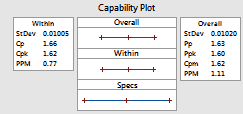|
|
Capability Sixpack - NormalGraphs - Within Capability Indices |
The Within capability indices are located in the lower center of the Capability Sixpack - Normal.
The potential (within) capability indices are associated with the within-subgroup standard deviation.
The industry guidelines determine whether the process is capable. A generally accepted minimum value for the indices is 1.33.
These indices reflect how the process could perform relative to the specification limits, if the shifts and drifts between subgroups could be eliminated. The capability indices consist of the following:
The output also includes PPM, which is the number of nonconforming parts out of one million parts.
A substantial difference between the overall and within capability indices may indicate that the process is out of control, or the sources of variation are not estimated by the within-subgroup component of variation.
Example Output |

Interpretation |
For the piston data, Cp is 1.66, which indicates that the specification spread is 1.66 times greater than the 6-s spread in the process. The values of Cp (1.66) and Cpk (1.62) are very close to one another, indicating that the process is centered. The capability indices are greater than 1.33, indicates that the process is centered and is capable of producing pistons that conform to specifications. PPM is 0.77, which indicates that only 0.77 parts out of one million parts are nonconforming.
The within and overall capability indices are very close to each other.